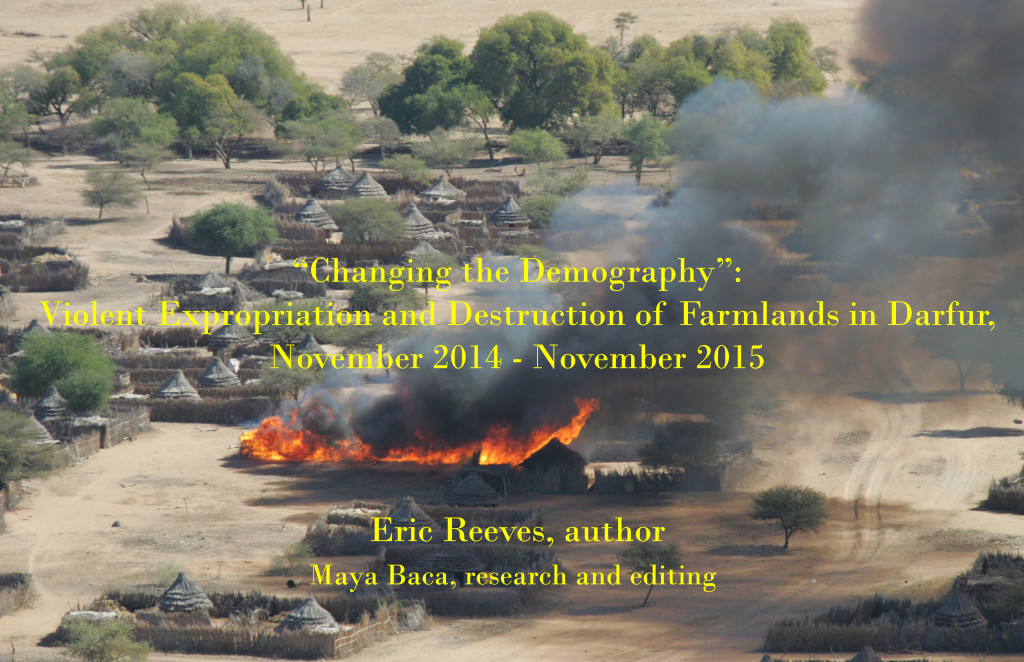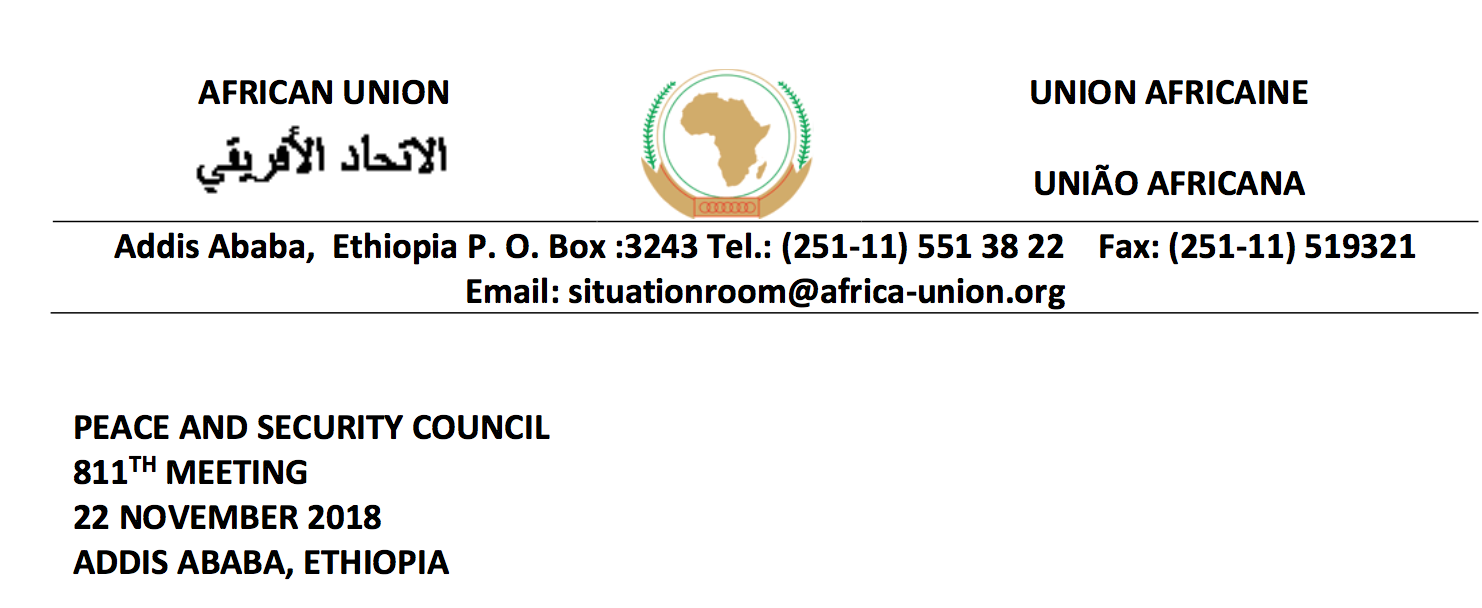On the Recent Communiqué from the African Union Peace and Security Council (811th Meeting | November 22, 2018 | Addis Ababa)
Eric Reeves | December 10, 2018 | https://wp.me/s45rOG-8936
Diplomatic efforts on behalf of Sudan and South Sudan by the African Union Peace and Security Council (AUPSC) constitute a litany of manifest failures and incompetent leadership. This includes not only the failure to secure either peace or security in Darfur but: the manifest and consequential failures of the UN/African Union Mission in Darfur; the failure to secure humanitarian access to the Two Areas (Blue Nile and South Kordofan); the failure to achieve a comprehensive cease-fire in the Two Areas; the failure—seven years after Southern secession—to establish clear borders between Sudan and South Sudan; the failure to acknowledge that the continuing Abyei crisis derives wholly from the Khartoum regime’s refusal to allow the region the self-determination referendum central to the Comprehensive Peace Agreement (2005)—a failure made grotesque by the AUPSC pretense that the cause of the crisis was anything other than Khartoum’s May 2011 military seizure of the area.
The AUPSC has at times been grossly mendacious, duplicitous—and relentless in its refusal to condemn Khartoum for massive and well-documented atrocity crimes, including deliberate bombardment of civilian and humanitarian targets, immensely destructive humanitarian embargoes, the use of chemical weapons (Jebel Marra, Darfur—2016), and the relentless attacks on civilians in Darfur by Khartoum’s militia proxies of the regime, currently the Rapid Support Forces (see Human Rights Watch report of September 2015). The AUPSC has also, predictably, been silent about rapidly growing and increasingly brutal political repression by the National Islamic Front/National Congress Party regime in Khartoum and other urban areas in Sudan.
Since 2009 the African Union’s diplomatic efforts have been led by a corrupt and biased Thabo Mbeki, a man Khartoum clearly sees as its useful lackey. What the AUPSC refers to as the “High Level Implementation Panel” is a perverse misnomer, since the name originally derived from a supposed “implementation” of Mbeki’s “Roadmap for Peace in Darfur,” a foolish and presumptuous map leading nowhere. And in its patent failure to address the critical shortcomings of the May 2006 “Darfur Peace Agreement” (DPA; Abuja, Nigeria) Mbeki’s “map” created an opening for the expedient Qataris to seize the diplomatic lead and oversee generation of the July 2011 “Doha Document for Peace in Darfur” (DDPD; Qatar). The massive failures of the DDPD are evidenced by the continuing violence that has wracked Darfur for the past seven years of genocidal counter-insurgency conducted by the Khartoum regime.
And because the DDPD was so accommodating of Khartoum’s interests, the regime refuses to allow for a successor agreement. Negotiations with most rebel groups in Darfur are continuing, but without the most significant of these leaders—Abdel Wahid, head of the Sudan Liberation Army/Movement, Abdel Wahid faction—and without the kind of civil society participation that was also rigorously excluded from the DDPD negotiations. Discussions of the critical issues of restitution of lands violently seized—and the meaningful protection of displaced civilians seeking to return—are simply not occurring. Ironically, the most promising venue for Darfur peace negotiations are occurring in Germany, not Addis.
In characterizing the supposed success of UNAMID, various past African Union heads of the mission have indulged in preposterous misrepresentations, contributing in highly significant ways to a diminishing of the international visibility of Darfur’s agony. For example, Rodolphe Adada of Congo, the first head of UNAMID declared arrogantly and wildly inaccurately that at the end of his tenure in 2009, “I have achieved results” in Darfur. “There is no more fighting proper on the ground.” “Right now there is no high-intensity conflict in Darfur. Call it what you will but this is what is happening in Darfur—a lot of banditry, carjacking, attacks on houses.”
Ibrahim Gambari, Adada’s success, was even more expedient and mendacious in his various outrageous claims, at point in 2011 claiming that during his tenure the number of displaced persons had been reduced from 2.7 million to 1.7 million, a decline of 1 million that was supported by no evidence other than Gambari’s misrepresentation of the UN’s Office for the Coordination of Humanitarian Affairs (CNN International [Khartoum], September 2011). In fact, in 2017 according to OCHA there were still 2.7 million displaced persons in Darfur—and according to the UN High Commission for Refugees more than 300,000 Darfuri refugees in eastern Chad.
At the end of his tenure, Gambari would be even more extravagant in his misrepresentations than Adada:
“I am gratified to note that barely 31 months on, all the set goals and objectives have largely been met. The Doha Document for Peace in Darfur (DDPD) was signed in July 2011”—Gambari’s assessment of September 2012 (UN Forum | Sept 15, 2012)
If among his “goals and objectives” in Darfur were peace, security, and a meaningful agreement for how the region might move forward, Gambari was a spectacular failure. Indeed, beginning in 2012 – 2013, with the creation of the Rapid Support Forces (RSF) as the primary instrument of war, destruction reached levels not seen since the earliest years of the genocide. I have chronicled in detail the period from November 2014 – November 2015, which largely continued the violence of the preceding two years, and would be succeeded by continuing large-scale violence, primarily by the RSF, through 2016 and the Jebel Marra offensive, which largely ended Darfuri rebel resistance:
“‘Changing the Demography’: Violent Expropriation and Destruction of Farmlands in Darfur, November 2014 – November 2015, “Eric Reeves, author, Maya Baca, research and editing; December 1, 2015 | http://wp.me/p45rOG-1P4
Gambari’s successors as head of UNAMID also failed to respond to this vast, immensely destructive violence—or even acknowledge its scale, or the responsibility of the Khartoum regime. Gambari had said at his departure party,
“The mission has indeed come a long way to protect civilians in a more robust manner and facilitate the delivery of the humanitarian assistance to those who are in dire need of it.” This was utterly disgraceful—and unchallenged—mendacity.
Perhaps most scandalously, following Gambari’s departure, the African Union Peace and Security Council declared at its meeting in May 2013 that UNAMID had been a “success” and was “worthy of emulation” in future operations.” This assessment came at the very time that violence was accelerating in Darfur and the horrors of genocidal destruction were becoming more and more evident, despite Khartoum’s efforts to exclude all human rights and international news reporting. History will record UNAMID as among the very greatest failures in UN peacekeeping history.
It is with this glaring and continuing failure of UNAMID in mind, and the refusal of the AUPSC to acknowledge this failure—or Khartoum’s responsibility for continuing human destruction and displacement—that we should read the November 22, 2018 “Communiqué from the African Union Peace and Security Council” (Addis Ababa). I offer several excerpts below, with brief commentary; but it is the long history of failure on the part of the AUPSC to address issues in greater Sudan with honesty and integrity that is most clearly “communicated” here:
4. Commends the members of the AUHIP, H.E. Thabo Mbeki, H.E Abdulsalami Abubakar and H.E. Ramtane Lamamra, and their support team for their diligent discharge of its broad mandate conferred by Council to assist Sudan and South Sudan to address their challenges relating to conflict and democratic transformation, as well as in the promotion of peace and security in the Horn of Africa.
[Mbeki and his cohort have been failing miserably on every single portfolio related to greater Sudan for more than nine years, and nowhere more consequentially than in Darfur. The existence of the preposterous “Doha Document for Peace in Darfur” (2009) can be directly related to Mbeki’s absurd “Roadmap for Peace in Darfur,” and the impossibility of implementing a document without support from any of the parties, least of all Darfuri civil society. And yet the AUPSC speaks of Mbeki’s “high-level panel as diligently discharging its broad mandate conferred by Council to assist Sudan and South Sudan to address their challenges.” There could hardly be a more misleading assessment. It is hardly surprising that Mbeki enjoys the trust and respect of no party other than the ruling junta in Khartoum—ER]
5. Further commends the Government of Sudan for the progress made in addressing the challenges in the country and urges the Government of Sudan and the other Sudanese interlocutors to engage and cooperate with the Panel in its efforts to re-energise the Roadmap process.
[In fact, it is impossible to specify what the “roadmap process” really is, and how it might begin to be comprehensive enough to address the myriad problems that confront Sudan and South Sudan, as well as their regional neighbors—ER]
11. Urges the Governments of Sudan and South Sudan to continue to implement their obligations under the Cooperation Agreement (2012), particularly, the implementation of the Safe Demilitarized Border Zone (SDBZ), the demarcation of the international boundary and the completion of the negotiations on the disputed and claimed areas, and requests the AUHIP to intensify its engagement with the Parties to encourage timely implementation of those commitments;
[Predictably, the AUPSC refuses to acknowledge what has been the primary obstacle to these border delineation and demarcation problems: the obdurate Khartoum regime—ER]
12. Calls upon the Presidents of Sudan and South Sudan to re-energise their engagement in cooperation with the Panel to address the Final Status of the Abyei Area and encourages the leadership of the two States, and the two Communities of the Ngok Dinka and Misseriya to engage each other to continue to contribute towards addressing the Final Status of the Abyei Area in a manner that will ensure the stability of the Abyei Area. In this regard, Council urges the two States to engage each other and mandate their representatives in Abyei Joint Oversight Committee (AJOC) to discuss and take decisions on the establishment of the Abyei Area interim institutions, in accordance with the Agreement on Temporary Administrative and Security Arrangements for the Abyei.
[See my assessment above of the origin of the ongoing issue of Abyei: until the AUPSC acknowledges the significance of Khartoum’s aborting the promised Abyei self-determination referendum (per the Abyei Protocol of the Comprehensive Peace Agreement)—and military seizure of the region in May 2011—there will be no true progress on the Abyei issues. Indeed, what is clear is a process of de facto annexation of the region is being undertaken by the Khartoum regime—ER]
16. Requests the AUHIP to continue the implementation of its Plan of Action, including the engagement of the Region and the Arabian Peninsula states, and the conduct further research and consultation to ensure that its proposals towards a comprehensive and inclusive approach of the complex dynamics in the Horn are firmly grounded in credible analysis which will inform the exposition of an genuinely African perspective on the challenges of the Horn. In this context, Council requests the Panel to report to Council on a quarterly basis on progress made, with a comprehensive report after the convening of the CPHA…
[“Plan of action,” “Roadmap process,” “High-Level Implementation Panel,” “Roadmap for Peace in Darfur”—all of a piece with the consummate bit of abstract and largely meaningless “diplomatese”: “…conduct further research and consultation to ensure that its proposals towards a comprehensive and inclusive approach of the complex dynamics… “
How can the AUPSC expect to be taken seriously if this is all it has to communicate?]


